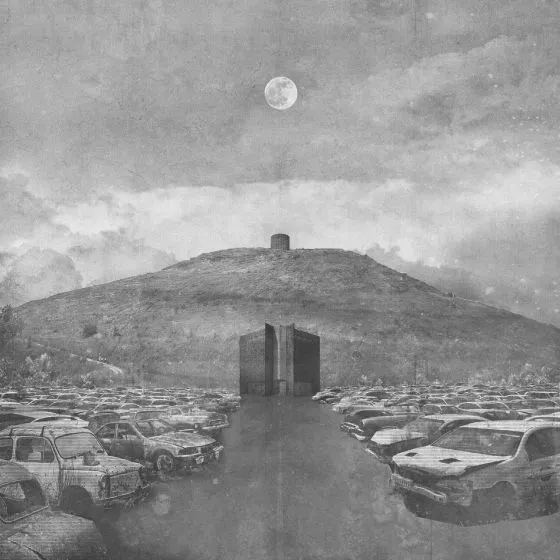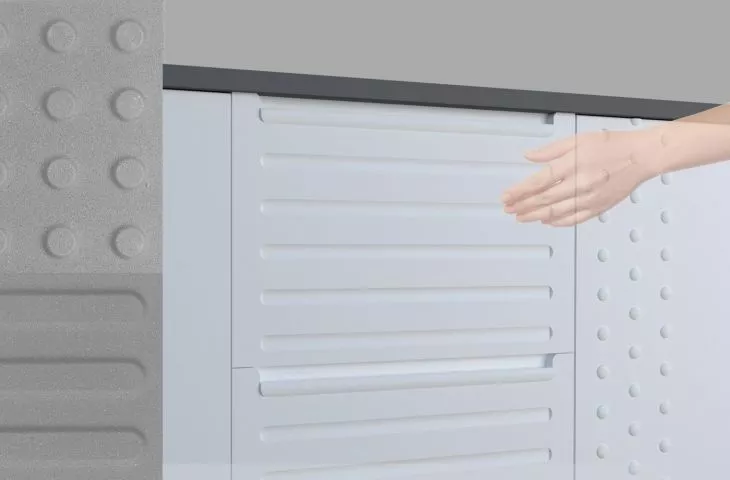How to help the blind and visually impaired in everyday life? This was the question posed by {tag:studenci} from the Jan Matejko Academy of Fine Arts in Cracow. The interior design student designed a furniture front system that makes it easier to move around in the kitchen and dressing room space. Meet the Invisible System.
The designer wanted to create a universal furniture front system that remains a flexible object, that is, one that will work in many spaces.
The system does not emphasize the difference between a sighted user and a blind user, so it can become a desirable item in the apartment of both a fully able-bodied and a blind person. Thanks to the convex and concave elements, the form of which is taken from the markings used on sidewalk slabs to help blind people navigate in public spaces, the design becomes a response to the aesthetic needs of people for whom touch is the sense responsible for perception and, most importantly, facilitates the functioning of blind users, the designer explains.
The Invisible System can be used, for example, in a kitchen built-in
© Julia Bugajska
Convex and concave elements help in finding cabinets and drawers and opening them. Lenticular dots have been used in the fronts of cabinet doors and build a kind of path leading to the concave elements, which must be pressed to open the cabinet. Horizontal stripes are used in drawers. The concave elements lead to a convexity that hides an undercut to open the drawer.
Lenticular convex points are used on the cabinets
© Julia Bugajska
Dobrawa Bies: What were the design inspirations?
Julia Bugajska: The starting point for the design was the consideration of the needs of people with disabilities. Not only functional needs , but also aesthetic ones. I focused on the unique group formed by blind people, for whom touch is the key sense responsible for the reception of design. In terms of form, the main source of inspiration was the markings used on paving slabs to help blind people navigate in public spaces.
Dobrawa: What were the furniture fronts made of? What were the design priorities?
Julia: Ultimately, the fronts will be made of lacquered MDF boards. The main design consideration was to create a universal system, making it easier for blind people to move around in the kitchen or closet space and remaining an aesthetic object. Initially, I planned to create a closet for clothes. However, in talking with blind people about their storage needs, I found out that this is an extremely broad issue that requires a universal solution. Users differ in their needs. Ultimately, the issue, resolved by a system that allows freedom of configuration.
Convexities and concavities create paths, guiding the user
© Julia Bugajska
Dobrawa: How does the design facilitate use?
Julia: Convexities and concavities create certain paths, guiding the user in the storage area. They suggest where and in which direction a cabinet opens, where a drawer slides out, and at the same time they give the fronts a unique look that makes them valuable also for a person who does not struggle with a visual impairment. The arrangement of concave and convex points allows for free configuration of the fronts, which can create many cohesive combinations.
The arrangement of concave and convex points allows free configuration of fronts
© Julia Bugajska
Dobrawa: How do you create designs so as not to exclude anyone? What in particular should you pay attention to?
Julia: A design that does not exclude is one that takes into account the specific needs of people with limited perception or mobility, but also remains sensitive to the aesthetic sphere. In this way, it is possible to create not only objects, spaces or technologies dedicated to a specific group, but accessible to all, ones that, whether for aesthetic or practical reasons, are desired by many different user groups. This is an approach that serves to offset the sense of exclusion that can be avoided if designers consider the needs of people with disabilities.
Dobrawa: Thank you for the interview.
The Invisible System project was created in the Furniture and Interior Elements Design Studio, led by Dr. Marek Blazucki and Anna Markowska. The work won the Deans' Award in the High Flights competition.









































